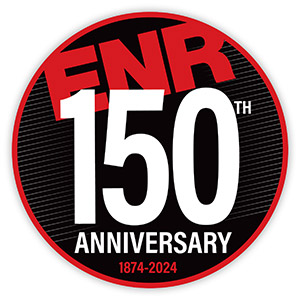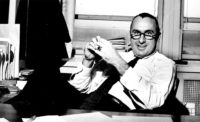
Engineering News in its early years was more of a civil engineering journal than its later incarnations (including Engineering News-Record), with numerous articles contributed by engineers. A number of its early editors were practicing engineers with little or no journalism experience. In 1886 it had 3,500 subscribers, and the staff consisted of three editors (two of them railroad engineers and the founder, George Frost, a former surveyor) and a clerk. “The office did not even boast a typewriter,” according to an article recounting the magazine’s history published in 1917. “Into this primitive and amateur publishing organization there burst in January 1887, a whirlwind of energy in the person of Arthur Mellen Wellington.”
Wellington “established the policy of investigating accidents to important engineering structures, for the purpose of obtaining lessons of practical interest to engineers.” The first such instance in his tenure was a railway disaster in March 1887, where a bridge in the Roslindale neighborhood of Boston collapsed as a commuter train was crossing it, killing 38 people. Right after hearing the news, Wellington “happened to meet a bridge-engineer acquaintance on the street [in New York City], Henry S. Pritchard, and asked him to take the first train to Boston and find the cause of failure of the bridge.”
Pritchard reached the scene 27 hours after the accident and “found almost at once the pair of broken floor-beam hangers whose failure had caused the disaster. Nobody apparently had paid any attention to them or realized their importance in a technical investigation of the causes of the wreck. An obliging workman knocked the hangers free from overlying wreckage, and Mr. Pritchard joined the procession of relic hunters who were carrying off souvenirs.”
Related Link:
The Original 1895 Text
“Great was the amazement of the railway officers and the authorities of the Commonwealth of Massachusetts when the next issue of Engineering News appeared two days later with a complete analysis of the accident and its causes, large-scale sketches of the hangers and the announcement that the very parts whose failure had caused the disaster were in the possession of Engineering News.”
“There was much talk in the Boston papers about criminal prosecutions for removing evidence and requisitions on the governor of New York, somewhat disquieting to the energetic engineer who had secured this valuable bit of scrap iron; but when the hangers were returned in due time to the custody of the State Railroad Commission, the excitement subsided.”
Wellington (1847-1895) had become an engineer the old-fashioned way, by apprenticing under a practicing engineer in Boston. Next, he worked as a leveler and assistant engineer under the noted landscape architect Frederick Law Olmstead. He then held positions of increasing responsibility with five railroads before the financial panic of 1873-74 put a sudden stop to railway construction. During this period of enforced idleness, he devoted his energy to the study of engineering problems, resulting in the publication of his first book, “The Computation of Earthwork From Diagrams.”
He proceeded to write a series of articles on “The Justifiable Expenditure for Improving the Alignment of Railways,” which were published in Railroad Gazette. They were reprinted in the form of a small book titled “Railway Location,” in 1877. The following year, Wellington became principal assistant to the chief engineer of the New York, Pennsylvania & Ohio Railway. He also found time to carry out experiments on the resistance of rolling stock and established formulas for train resistance at low velocities. He then served as engineer-in-charge of location and surveys for the Mexican National Railway. In 1884, he joined Railroad Gazette as an editor.
He greatly expanded his book, whose full title became “The Economic Theory of the Location of Railways: An Analysis of the Conditions Controlling the Laying Out of Railways to Effect the Most Judicious Expenditure of Capital.” From the slim, 200-page original edition, the second edition, published in 1887, grew to 980 pages, with 313 engravings and 204 tables. “It remains one of the most comprehensive treatises on the subject of railway engineering ever written,” says Prof. Christopher P.L. Barkan, who teaches railway engineering at the University of Illinois. “I cite Wellington’s principles to explain railroad decision-making vis-à-vis the level of sophistication of train control systems used, based on rail traffic levels and operating objectives in my course on railway signaling and control.”
The book established Wellington’s reputation in a wider arena. “Wellington is regarded as the father of the subject of engineering economy, which is the analysis of the economic consequences of engineering decisions,” commented Dr. James B. Calvert, professor emeritus, University of Denver. Wellington “realized that railroad companies required a more sophisticated method for evaluating capital investments than those used by other contemporary American industries,” wrote Scott P. Dulman in an article in The Business History Review. “Wellington was apparently the first to advocate the use of present value analysis to evaluate industrial capital budgeting alternatives. The present value method (a component of discounted cash flow analysis) developed by Wellington, and improved by engineering academics after the First World War, overcame the deficiencies of the return on investment method.”
In 1888, a reader of Engineering News inquired as to the best formula for determining the safe bearing capacity of a pile. Wellington’s response came to be recognized as one of the most important statements ever made on that subject. It later became known as the Engineering News formula.
“At that time, most piles were timber (not steel or concrete), and they were driven with drop hammers or early steam hammers,” says Steve Wendland, president, Bedrock GeoConsult. “The measurements needed for the formula are the weight of the hammer, how far the weight is dropped to impact the top of the pile and how far into the ground the pile penetrated when it was struck by the hammer. Mr. Wellington’s understanding that the capacity of a pile could be quantified based on this information was cutting-edge engineering for that time.”
Over time, understanding of soil strength and pile capacity improved, and many full-scale pile load tests were completed. With that more advanced knowledge, civil engineers began to understand that the formula was often inaccurate. Also, pile-driving equipment was improved as diesel hammers became available, and timber piles were mostly replaced with steel and precast concrete piles.
“By the 1970s and 80s, entirely new and much more accurate methods were developed,” says Wendland. “These new methods used field equipment to measure the flow of energy through a pile and penetration of the pile as it was driven. Despite the understanding of its inaccuracies and the development of new methods, the formula survived and continued to be widely used for more than 100 years beyond its original publication. As late as the [first] decade of the 2000s, some state departments of transportation continued to use the formula as their standard method of confirming pile capacity during construction,” he notes.
Wendland explains that it was only in the first decade of this century that the “structural engineering practice was significantly changed in the U.S. as design methods evolved to use load and resistance factor design [LRFD] methods instead of the old allowable stress design methods. LRFD methods significantly penalized pile designs that relied on the Engineering News formula, requiring use of a resistance factor that was 75% to 85% less than other more accurate methods. The EN formula is still provided in LRFD design manuals published by the Federal Highway Administration, but the requirement to use very low resistance factors with the EN formula makes it so uneconomical that it is rarely used. Modern geotechnical engineering textbooks (e.g., “Principles of Foundation Engineering” by Das) still teach the formula, but not as a preferred method.”
As recently as 2005, an engineer contacted the editors of ENR asking for the formula, as he was working on a project at the time where existing 10-in.-dia wood piles were rated based on the formula.
During his editorship, Wellington continued to do some consulting work. He gave advice on the elimination of grade crossings in Buffalo, the foundation of the Board of Trade Building in Toronto and spoke to the Massachusetts Legislature, recommending the best solution for locating the Tremont Street subway in Boston.
A measure of the breadth of his impact is that two distinct branches of engineering, the American Society of Civil Engineers and the Institute of Industrial and Systems Engineers, have each established annual awards in Wellington’s name.
There’s a long-established engineering aphorism that states, “An engineer can do with one dollar what any fool can do with two dollars.” After publishing the quote in a special ENR publication in 2004, a longtime ENR subscriber noticed it and directed me to the introduction of Wellington’s book. There in his introduction was this passage: “It would be well if engineering were less generally thought of, and even defined, as the art of constructing. In a certain important sense it is rather the art of not constructing; or, to define it rudely but not inaptly, it is the art of doing that well with one dollar, which any bungler can do with two after a fashion.”





Post a comment to this article
Report Abusive Comment